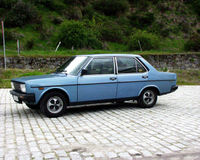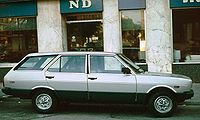
SEAT 131
Encyclopedia


Family car
A family car is a car classification used in Europe to describe normally-sized cars. The name comes from the suitability of these cars to carry a whole family locally or on vacations. Most family cars are hatchbacks or saloons, although there are MPVs, estates and cabriolets with the same structure...
produced by the Spanish
Spain
Spain , officially the Kingdom of Spain languages]] under the European Charter for Regional or Minority Languages. In each of these, Spain's official name is as follows:;;;;;;), is a country and member state of the European Union located in southwestern Europe on the Iberian Peninsula...
car manufacturer
Automotive industry
The automotive industry designs, develops, manufactures, markets, and sells motor vehicles, and is one of the world's most important economic sectors by revenue....
SEAT
SEAT
SEAT, S.A. is a Spanish automobile manufacturer founded on May 9, 1950 by the Instituto Nacional de Industria , a state-owned industrial holding company....
from 1975 to the middle of 1982. The SEAT 131 was presented on May 1975 in the Barcelona Motor Show as a response to the consumers' demand for greater fuel economy combined with spaciousness, under the raising concern due to the 1973 oil crisis
1973 oil crisis
The 1973 oil crisis started in October 1973, when the members of Organization of Arab Petroleum Exporting Countries or the OAPEC proclaimed an oil embargo. This was "in response to the U.S. decision to re-supply the Israeli military" during the Yom Kippur war. It lasted until March 1974. With the...
.
With SEAT having formed a partnership with Fiat, the SEAT 131 was a model based on the Fiat 131
Fiat 131
The Fiat 131, additionally called "Mirafiori", is a small/medium family car produced by the Italian car manufacturer Fiat from 1974 to 1984. It was exhibited at 1974 Turin Motor Show....
a car presented nine months earlier in Turin, however the Spanish model was adapted to the needs and the specificities of the Spanish market. The SEAT 131 started its making in early 1975 in Barcelona and up to the end of its production life cycle 412,948 units were produced.
Versions
Two sedan versions were offered: the SEAT 131 L, featuring rectangular front lamps, 1,438 cc OHC engine and 4 speed gearbox and the SEAT 131 E featuring four round headlamps, 1,592 cc DOHC engine and 5 speed gearbox.The range grew up in the spring of 1976 with the SEAT 131 5 puertas unofficially known as the SEAT 131 Familiar, which was the estate version offered with both engines. In 1977 the 131 Automatico (Automatic gearbox) was released and the following year a very short production of the SEAT 131 CLX 1800 was offered. Spain was the only place where the estate 131 was built, but in the export these were labelled Fiat 131 Familiare.
In 1978, the SEAT 131 evolves into the SEAT 131 Mirafiori/Supermirafiori (Panorama for the estate versions), with the same changes as seen on its Italian cousin. The engines remained largely the same, but a 1.8 liter Diesel Perkins 4.108 engine was available in 1979.
In 1981, the Diesel version was developed with a new Sofim engine. This 2,500 cc engine was much more powerful than the Perkins version (72 hp against only 49 hp) and was one of the most successful taxis in early '80s Spain.
Also, another CLX special edition was launched in 1980. Available only in metallic silver or metallic bronze colours, this 131 CLX had a 1,919 cc engine, developing 114 PS at 5,800 rpm.
In 1982, the SEAT 131 changed again, gathering all the body changes seen on the Fiat 131 series 3. The 131 was now available in CL, Supermirafiori and Diplomatic versions. The Diplomatic was the top of the range, with a 1,995 cc engine and features such as power steering, power windows or air conditioning. The Panorama versions were the cars chosen by the "Cuerpo Nacional de Policia" (Spanish Police force) as patrol cars.
In 1984, the whole SEAT 131 range was phased out, without a direct substitute. The brand new Ritmo-based SEAT Málaga
SEAT Málaga
The SEAT Málaga is a four-door saloon produced by the Spanish automaker SEAT from 1985 to 1992, named after the city of Málaga in Andalucía, southern Spain....
took its place in 1985.
Curiosities
The implementation of the diesel engines in the SEAT 131 range came not earlier than almost four years after its launch. This would practically exclude the use of the SEAT 131 in the taxi fleet, in spite of its significant performance in both comfort and roominess.In the meantime however, for a great number of Spanish taxi owners and other professionals who were opting for the SEAT 131 as their taxicab of choice, a very common practice was the after-market replacement with a diesel engine of a newly-purchased gasoline-powered SEAT 131. Engines that were widely used for this purpose were derived from Perkins, Barreiros, Mercedes-Benz and Sava, but the most widespread option was the 52CV Sava 1,795 cc engine.

